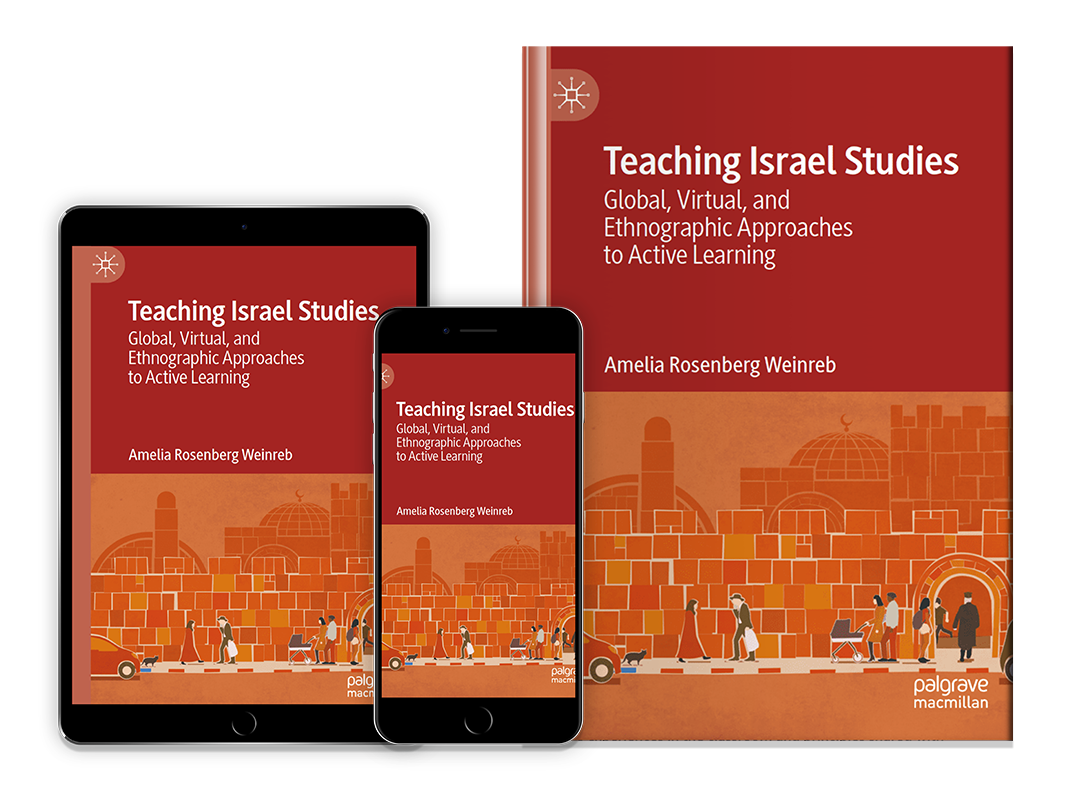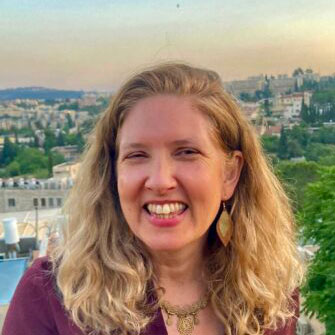Teaching Israel Studies
Pedagogical strategies for today’s
diverse Israel Studies classrooms

Coming December 8, 2022
About The Book
This book presents pedagogical strategies for today’s diverse Israel Studies classrooms. It offers Israel-specific innovations for online teaching, tested methods for organizing global virtual exchanges that uplift marginalized voices in Israel, including Palestinian voices, and an intellectual and political overview of the field. Informed by the author’s experiences in the classroom and principles shared with her by fellow instructors, the book provides a guide to developing an Israel Studies syllabus or integrating Israel Studies units into an existing curriculum.
“Amelia Weinreb has written a thoughtful and thought-provoking reflection on her own teaching practice of Israel Studies in higher education. Grounded in her training as a cultural anthropologist, an insightful reading of recent research in the learning sciences on active learning in higher education, and many years of face-to-face and online teaching of courses dealing with Israel to diverse populations of undergraduate students at American and Israeli universities, she has penned a highly readable guide to teaching this academic subject matter at the tertiary level. Especially useful to those teaching the subject for the first time, but also of interest to experienced instructors of the field from a variety of academic disciplines, Weinreb offers a student-centered approach to this often contested subject matter in ways that will enable students to sharpen their analytic skills and to formulate their own evidence-based opinions concerning its many political, cultural, religious, and ideological complexities.”
What’s inside
Carves out a new pedagogic path for existing and future scholarship in Israel Studies
Provides examples of theoretically and culturally engaged Israel content for global classrooms
Includes strategies for virtual learning, on-site instruction from Israel, and forging institutional partnerships
PREFACE
Israel Studies is a rapidly growing field. What was a smattering of Israel-related boutique seminars on the margins of primarily US college campuses only 10–15 years ago has now been thrust into mainstream classrooms and incorporated into core curricula at major universities across the globe, with courses now offered in at least 262 universities in 29 countries, spanning 6 continents. How can hundreds of new courses on the modern State of Israel—one of the most polarizing and highly politicized countries in the world—be taught effectively to an expanding international audience?
With this question in mind, I present pedagogical strategies for today’s diverse Israel Studies classrooms. These include Israel-specific innovations for online teaching, tested methods for organizing global virtual exchanges that uplift Palestinian and other marginalized voices in Israel, and an intellectual and political overview of the field, which I argue should inform course delivery. The book offers a rare peer-reviewed, single-volume developed for the expanding global market of international Israel Studies instructors teaching international cohorts. It is a guide devoted to consistently distinguishing the incisive, academic study of the State of Israel from Israel advocacy in higher education.
BACKGROUND: GROWTH OF ISRAEL STUDIES
Beyond its boom in undergraduate education internationally, the scholarly infrastructure for Israel Studies as an academic discipline has solidified in the past decade. It is supported by a slate of academic programs, endowed chairs, institutes, fellowships, lecture series, instructor training, visiting scholars, research grants, as well as extensive course offerings. Israel Studies now has two professional associations (the Association for Israel Studies since 1985 and the European Association for Israel Studies since 2011), both of which host robust annual conferences. They attract a future generation to Israel Studies by offering graduate student workshops, best dissertation prizes, and first book awards for early career scholars. Authors can now submit their manuscripts to four competing Israel Studies scholarly journals. Two English-language university presses now also advertise an Israel Studies monograph series, separate from their existing Jewish Studies or Middle Eastern Studies lists.
Collectively, these institutional frameworks point to a growing number of outlets for the rising stream of Israel-related scholarship and indicate the strong potential of Israel Studies’ disciplinary longevity and the continuing demand for instructors. This upward trajectory of Israel Studies since the mid-2000s is also somewhat unexpected given the general decline of other Area Studies, Ethnic Studies, or country-specific academic programs, whose shrinking enrollments and diminishing budgets mirror the broader struggles of the humanities and social sciences.
I do not write about this sudden surge in Israel Studies as a laudatory advertisement. Reasonably, critics have greeted it with skepticism and there is a difference between the increase of chairs, centers, and endowments versus steady, enthusiastic enrollment in Israel Studies courses themselves. In any case, what animated the rise in Israel Studies is crucial to understanding it as a new academic field and formulating effective teaching curricula.
The first Israel Studies centers were established in the US in 1998, but most were founded between 2007 and 2017. During this period, Israel Studies content in North America was generally crafted for undergraduate audiences through programs established with the help of primarily American-Jewish philanthropists. As staunch Israel supporters, they were concerned by two trends: the escalating anti-Israel sentiment and activism on college campuses; and an entrenched, normative anti-Israel curricular bias, which they traced to an earlier, competing funding stream: wealthy Arab states and individual donors supporting university chairs and centers in Arabic, Middle Eastern, and Islamic studies since the 1970s.
The political motives of donors to Israel Studies programs instantly cast a shadow over its perceived academic integrity. For this reason, Israel Studies’ scholarly rigor and high academic standards remain integral to its stated mission, though this has not prevented calls to boycott university programs, which critics see as inherently biased. The irony here is that, in reality, Israel Studies syllabi and teaching faculty fall along a left-leaning political spectrum, and donors often have quite limited control over curricular decisions. Nonetheless, distrust had been sown from the outset. In its critics’ eyes, Israel Studies’ commonly shared aim to discuss Israel’s “complexity,” “flaws,” and “diversity” has been interpreted as code words for hasbara (Israel propaganda or public relations efforts) and tightly associated with Israel’s positive rebranding as modern, multicultural, democratic, and innovative, with national problems and prospects divorced from the Israeli-Palestinian conflict.
Discourse that normalizes Israel through complex or nuanced characterizations runs counter to the anti-normalization goals of BDS (Boycott, Divest, Sanction) and delegitimization movements like the Palestinian or US Campaign for the Academic and Cultural Boycott of Israel. These movements reject what they see as tactics to whitewash Israel or deflect the conversation away from what they believe should be the exclusive focus regarding Israel: occupation, Zionist settler colonialism, war crimes, ethnic cleansing, and apartheid.
Despite these tensions, Israel Studies’ politicized underpinnings are not always explicitly transmitted to instructors or students. This politicization, combined with its rapid growth, has led to a common scenario. Young scholars, few of whom are trained in navigating the campus politics of Israel Studies (though some are Israeli), are recruited to teach and then dispatched to various classrooms. They arrive without completely understanding campus climates or how students might interpret their tone, stance, or course content. Nor are instructors given sufficient—or sometimes any—preparation to help them translate their knowledge into syllabus design or navigate classroom encounters.
Although boycotts and anti-normalization efforts continue, they have not stopped the global expansion of Israel Studies programs. On the contrary, Israel’s critics and advocates alike have argued that BDS has only increased the proliferation of Israel Studies, as donors have shifted their funding from Jewish Studies toward education related to Israel, which they feel is more topical and urgent. Consequently, study abroad opportunities and academic and professional internships are now increasingly offered in Israel. In addition, while Israel has long been a topic of interest for Israeli scholars, international MA degree programs in Israel Studies now operate in all four of Israel’s major universities.
Most recently, Israel Studies has become embedded across Asia, primarily motivated by a mutual interest in increasing science, technology, and business ties. In 2012, a center was established in India’s Jindal School of International Affairs. Since 2014, eight Israel Studies programs have been established at Chinese universities alone. Also, South Korea, Japan, Singapore, the Philippines, Vietnam, Taiwan, Nepal, Mongolia, and, most recently, Indonesia are now engaged in exchanges with Israel, sending fellows annually through Hebrew University’s Israel-Asia Center. As a result of these collaborations, Israel Studies workshops have been designed for companies, organizations, and universities, ranging from one-day semi
nars and workshops to eight-month programs.
The 2020 Abraham Accords, the initial normalization agreements between Israel, the United Arab Emirates, and Bahrain led to additional normalization agreements with Sudan and Morocco and have begun to generate a host of new academic partnerships and collaborations with Israeli institutions. Preliminary meetings, intercultural exchanges, and teaching Israel Studies workshops took place in July 2022 through Brandeis University’s Summer Institute for Israel Studies studies, and courses will logically follow. Together, these scholarly and institutional developments, national and international, reflect Israel Studies’ vitality and highlight the need for pedagogical materials for a broad and increasingly diverse audience.
In contemplating course design and audience diversity, I grew interested in learning how other Israel Studies instructors approach teaching, particularly given its extensive growth. I wanted to hear both from the experienced instructors in North America and the growing legions of international scholars, particularly those in China, South Asia, Africa, Latin America, and the Middle East. How is their teaching different, and how will it shape the globalizing future of the field? Along with a team of research assistants, I conducted 40 in-depth interviews with Israel Studies faculty and center directors in 15 countries about their experiences and perspectives. Despite the growth and global spread of Israel Studies particularly over the last 25 years, challenges in teaching remain and are best approached when contextualized for the local instructors and student body. These problems, along with the growth of BDS on campuses and the sheer number of Israel Studies courses produced today, indicate the critical need for a thoughtfully constructed, politically-attuned, peer-reviewed teaching guidebook.
MOTIVATION TO WRITE THIS BOOK
I have taught various lively and well-received Israel Studies courses or course units each semester for the past 13 years and counting to students in a large public US university, The University of Texas at Austin, for the eight years at an international program at The Hebrew University in Jerusalem, and now at NYU Tel Aviv. Despite my sustained level of engagement with Israel Studies, I do not pretend to be an Israel expert. Some scholars have spent their entire training and academic careers conducting research and publishing on Israel or have taught on Israel or the Middle East for decades before the existence of Israel Studies as a formal field. I have not. I am also unlike people who grew up Jewish or with the message that Israel is vital to Jewish life. For transparency and context, I will briefly relate my story and motivations for writing this book and lay bare my vulnerabilities and perspectives.
Trained in cultural anthropology in the 1990s, I am a product of the reflexive turn: the scholarly interest in a researcher’s individual emotions, beliefs, practices, and judgments in relation to their writing. I still believe in the importance of situated knowledge or that all knowledge reflects the conditions in which they are produced, and the identities and social location of the author. In this vein, I attempt to maintain my students’ awareness of what has become a truism in the humanities and interpretive social sciences: All authors, teachers, and students have perspectives, but they also have vulnerabilities—whether great or small, hidden or overt, intellectual or personal—as does the work they produce. A writer can choose to lay bare their positionality actively, or the audience might seek what they can about an author. However, not all meaningful or revealing details can be found through online searches or sniffed out through social media. How authors choose to tell their own stories and explain how their life experiences have shaped their knowledge is compelling in its own right.
In brief, my story is the following: I spent my entire childhood in a politically liberal, middle-class, pacifist, predominantly white, ecumenical, mid-western college town (East Lansing, Michigan, home of Michigan State University). I was raised in a religiously unaffiliated household, the child of a mixed Jewish-Christian marriage with few rituals and even fewer restrictions. The privilege of an indistinct ethnoreligious identity, combined with a “love-all, serve-all” ethos common in communities like mine in the, post-Vietnam 1970s–1990s US, was an openness to exploring cultural identities other than one’s own and the freedom to sample new communities of belonging. (This approach to the “cultural buffet” and the global village was particularly true in the decades before anxieties about cultural appropriation had peaked). The worth of all people groups held equal value, and logically, placing one’s own group first was considered incorrect. Assimilation was not discussed as an existential threat in my social world because preserving a particular identity was not an active struggle. It followed naturally then that nationalism, patriotism, ethnocentrism, and military service were looked down upon as dangerous and outmoded forms of belonging that had no place in this milieu. Instead, international travel was a valued part of the educated, liberal aesthetic, leading to regional fetishes and language fluencies most often unrelated to one’s family heritage. Latin America, Africa, and South Asia were trendy destinations, and cross-cultural romance in my peer group was normal.
Despite this cosmopolitan outlook, the State of Israel and the Hebrew language were neither active interests nor subjects of particular concern or debate in my family and my community. Antisemitism, Zionism, the rules of observant Judaism, Israeli politics, and the Israeli-Palestinian conflict all remained exceedingly unfamiliar to me growing up. This background surprises some students in my classes and reasonably expect my distinctly Jewish-sounding last names to signal a particular Jewish-American identity. Affiliated Jewish students sometimes mistakenly assume I would have shared life experiences with them. Why would I not have been ensconced in the same types of Hebrew schools, Jewish summer camps, day schools, youth movements, bar and bat mitzvah celebrations, or religious congregations as they had been? But I did not have these experiences, nor did I travel on Birthright or other organized tours that introduce its charges to the importance of Israel to Jewish peoplehood or how to confront the controversies Israel attracts.
There was no Hillel to attend during my undergraduate years on a small Quaker liberal arts campus (Earlham College), espousing a very similar worldview as my hometown. Although there was criticism of Israel’s policies related to Palestinians, it remained in the background. In my mind, Israel and the conflict simply had nothing to do with me, my identity, or my academic course of study. So, just as I could choose to be interested in Cuba, I could decide not to be interested in Israel. Israel’s remoteness remained even through my years of doctoral training in cultural anthropology at the University of Pennsylvania. It was not Israel and the Middle East, but Latin America and the Caribbean that provided my geographic focus during my PhD and became part of my Area Studies teaching repertoire in my early years of instruction and publication. When it came to Israel, I remained both emotionally detached and politically unindoctrinated.
In fact, I had never even visited Israel until I was suddenly on the brink of moving there myself at age 30—tepidly making aliyah—a novel category of international migration for me, and something no one in my immediate social network had ever done, but which I agreed to do with my new husband and our toddler. It was not only that I came from a background in which flexibility with international living adventures was socially normal, making such a move conceivable. At a more intimate level, my husband had never imagined raising a family anywhere other than Israel, and Israel was central to my new extended family’s life and identity. I was already eligible to obtain Israeli citizenship based on my father’s Jewish status, but there was a more pressing complication. I wanted my new, extended Jewish family to accept our children fully as members, which had profound implications for my religious status at the time.
Orthodox standards dictate that only mothers pass on Jewish status to their children, so my acceptance into the fold was conditional on our children being halachically Jewish—Jewish by Jewish law. Although my father was Jewish, my mother was not, so by these standards, nor was I. So, before the Israel move, I had completed a rigorous Orthodox conversion that secured my halachically Jewish status and that of any child born to me from then on. Ultimately, over the course of a whirlwind year, I went from being a college town American with no clear ethnoreligious identity to having a decidedly marked ethnoreligious identity that I was now passing on to the next generation and through a distinct new national citizenship with all of the responsibility that both carried.
I had agreed, before departure, to live in Israel on a long-term trial basis (initially five years). But not forever. Landing in Tel Aviv in October 2002, during the second intifada, I brought little of the emotion, associations, convictions, or politics that fellow new Olim typically do. Instead, I met both the move to Israel and conversion to Judaism with intellectual curiosity, ideological detachment, deep family commitment, and willingness as a cultural observer. Throughout the conversion process and beyond, I became intimately involved—and at times in charge of— producing a Jewish home life with which I had not grown up. I learned culturally and ritualistically appropriate ways of being Jewish and observing local Jewish life professionally as an ethnographer. In other words, I had the rare opportunity to profoundly engage in the ethnographic method of “participant-observation” in the Israeli setting.
For the past 20 years, I have lived back and forth between Israel and Austin, Texas. I have experienced significant milestones in Israel with my spouse and four children, including giving birth, caring for babies, ushering small children through daycare, and older kids through various more- and less- religious public elementary, middle, and high schools covering every grade, and various chugim (extracurricular activities). Most recently, I have watched a young adult daughter move through the army and post-army transitions. I have voted in multiple Israeli elections and witnessed waves of political violence and social protests. I have experienced the rhythms of daily life in Tel Aviv, Mitzpe Ramon, and three distinct neighborhoods of Jerusalem for at least one year in each location. Professionally, I have completed a postdoc in Israel, supervised internships, published research on Israel, and, most importantly to this text, taught many courses on Israel.
Despite all this exposure, immersion, and analysis, I am still baffled by certain Israeli cultural practices and fatigued by particular social norms. With some frequency, I still make embarrassing missteps of a foreigner, especially acute in the eyes of my Israeli or aspiring-Israeli children, who wish I could more effortlessly conform. Even after all these years, I still desperately prefer English to Hebrew. I feel I have never entirely been an insider—not in the Jewish world and not as an Israeli. But now, I am not entirely an outsider, either.
Straddling the insider-outsider divide is both a burden and a gift since it provides a unique vantage point while teaching about Israel. It has sharpened my power of comparative cultural observation and preserved an edge that enables me to translate cultural experiences more fluently and less defensively to American and other non-Israeli and non-Jewish audiences. Of course, no one’s long-term relationship to any place is static, and the sheer force of time makes the alien familiar. This in itself has generated many meaningful classroom discussions about the concepts of “home.”
As relationships to places develop over time, so does teaching about those places. In 2009, as a newly hired lecturer in the anthropology department at UT, I created my first Israel course to be cross-listed with Jewish studies and Middle Eastern Studies. I had never taken a class in Israel Studies, and I only began reading and writing about Israel academically after my PhD while accruing lived experience “in-country.” So, consequently, I completed my academic study of Israel independently, eclectically, and often on-site using the ethnographic research and analytic skills I had learned as a cultural anthropologist but had only practiced in other national settings before my years as a postdoc.
Although it is not unusual for university instructors to arrive to the classroom without direct training in the subjects they teach throughout their career, it is seldom discussed. Partly as a result of this, increasingly, college instructors no longer replicate syllabi, draw from a cannon, or carry a narrative thread from one generation of scholars to the next. While such freshness can generally lead to keen insights and independent interpretations in Area Studies, lack of disciplinary inculcation comes with the risk of sounding tone deaf to regional experts and audiences, particularly those that expect a standard academic and political stance on contemporary Israel.
Setting out into Israel Studies, I knew—but did not realize the extent to which—the most widely accepted academic narratives about Israel exist range between sharply critical and demonizing of Israel. In those country-specific (post)colonial studies which focus on a colonizing force in general, and Israel as a settler-colonial society specifically, this is to be expected. So, in other words, although there is no Israel Studies canon, on many campuses, at least in North America, there is an assumed stance toward Israel that shapes course material.
For all these reasons, when starting my teaching career, I certainly could have used a book like this to lead me. I wrote this book to those Israel Studies instructors, at any stage, who sense they need a compass to reorient them and are open to being guided by one with my particular experiences, perspectives, and vulnerabilities.
Jerusalem, Israel
Amelia Rosenberg Weinreb







